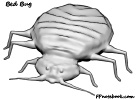II. Epidemiology
III. Pathophysiology
- Images
- Obligate blood Parasite in the Cimicidae family
- Two species primarily affecting humans
- Cimex lectularius
- Cimex hemipterus
- Life stages (6-12 month lifespan)
- Egg
- Adult females produce up to 500 eggs in their year long life span
- Adheres to surfaces via a glue-like substance
- Nymph (5 distinct stages)
- Size of sesame seed (1 mm)
- Lighter color and translucent
- Adult
- Size of lentil (4-7 mm long)
- Red-brown flat, oval and wingless
- Egg
- Feeding
- Bed Bugs avoid light and remain hidden in mattress or furniture during day
- Bed Bugs are attracted to carbon dioxide (typically from people sleeping with 1-2 meters of their hiding place)
- Bed Bugs typically feed immediately before dawn
- Feed for 5-10 minutes
- Saliva contains Anesthetic that prevents host from initially recognizing the bite
- Hypersensitivity Reaction follows on host awakening
- Hardiness
- Can withstand not eating for up to one year
- Can withstand fogging devices and most Pesticides
- Bed Bugs can survive Temperatures between 44 and 113 F (7 to 45 C)
IV. Background
- Transmission into home
- Travel items (Luggage, Clothing, Shoes)
- Conduits (e.g. electrical wiring, ventilation system between rooms or attached apartments)
- Common Sites in home (Bed Bugs avoid light)
- Mattress or box spring seams and underside
- Wheel Chairs
V. Symptoms
- Moderate to intense Pruritus
VI. Signs: Bite Reaction
- Reaction is allergic and occurs in 70% of patients
- Characteristics
- Initial reactions are Red Papules with centra puncta in line or group
- Later reactions are variable lesion types (e.g. Papules, wheals, vessicles)
- Bites form linear pattern
- Often form line of 3 bite sites (breakfast, lunch and dinner)
- Distribution of bite sites on exposed skin
- Face and and neck
- Arms and legs
- Back
- Spares popliteal fossa and axilla
- Course
- Resolves spontaneously in 1-2 weeks
VII. Differential Diagnosis
- Bedbugs
- Pruritic row of Papules or wheals on exposed skin (excoriations may alter appearance)
-
Fleas
- Irregularly grouped wheals each with central bite site on loosely covered skin (e.g. waist band)
-
Scabies
- Pruritic burrows especially in intertriginous areas (e.g. web space)
-
Tick Bite
- Red Papule with variable Pruritus often in areas of Hair Growth or in skin creases
-
Mosquito Bite
- Small pruritic wheals randomly scattered over exposed skin
-
Spider Bite
- Isolated, single lesion typically on thin skin covered with clothing
VIII. Management: Identification and elimination of Bed Bugs
- Examine furniture, bedding, curtains, luggage seams with magnifying glass
- Observe for blood tinged tiny feces and exoskeleton casts
- Consider searching just before dawn with a flashlight (when Bed Bugs are most active)
- Identify infestations early
- Easier to eradicate at an earlier stage (prior to infestation of wiring)
- Travelers
- Inspect hotel room well on arrival and throughout stay
- Place luggage on rack well above ground
- Consider traveling with portable heating unit (Packtite) to treat luggage
- Quarentine items suspected of infestation
- Place items in sealable plastic bags
- Consider plastic encasements for mattress and pillows
- Vaseline applied to furniture legs prevents Bed Bugs from climbing
- Detection and monitoring
- Climbup Insect Interceptor (moat device)
- Nightwatch Monitor (emits carbon dioxide from a trap)
- Consider dogs that have been trained to specifically smell for Bed Bugs in hospitals, Nursing Homes
- Eradicate Bed Bugs
- Consult with local pest control experts (exterminators)
- Variety of Pesticides used (silica gel dusts are safer options)
- Typically requires multiple treatments (spaced 2-3 weeks apart)
- Methods
- Heat to over 120 F for at least 30 minutes to kill Bed Bugs
- Cool at <23 F (-5 C) for 5 days or -15 F (-26 C) instantly
- Vacuuming removes Bed Bugs (but not eggs)
- Consider hand held steamer in commercial settings
- Consult with local pest control experts (exterminators)
IX. Management: Bed Bug Bites
- See Pruritus Management
- No specific treatment is available
X. Complications
- Related to scractching pruritic lesions
- Cellulitis
- Impetigo
- Theoretical vector for disease transmission (but no case reports of this)
XI. Resources
- EPA Bed Bug Product Search
- National Pesticide Information Center
- University of Minnesota
XII. References
- Kells (2006) Guide for travelers to prevent bringing home Bed Bugs, UMN Extension
- Marco (2013) Crit Dec in Emerg Med 27(1): 2-7
- Weingart and Jones in Majoewsky 2012) EM:RAP 12(4): 2-3
- Heymann (2009) J Am Acad Dermatol 60(3): 482-3 [PubMed]
- Studdiford (2012) Am Fam Physician 86(7): 653-8 [PubMed]

